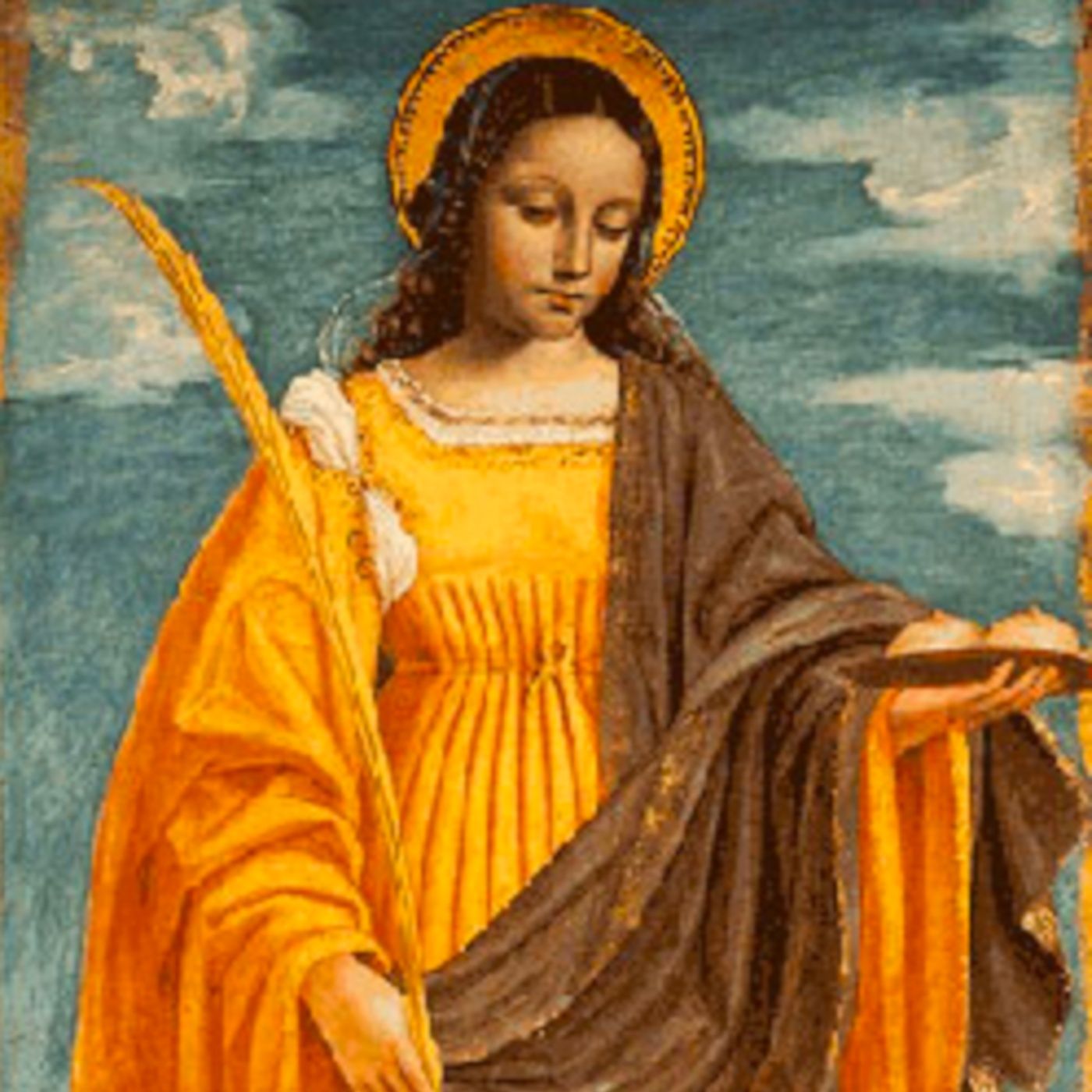
February 5: Saint Agatha, Virgin and Martyr
c. Third Century
Memorial; Liturgical Color: Red
(When Lenten Weekday, Optional Memorial; Violet)
Patron Saint of Sicily, breast cancer, rape victims, and bellfounders
Of all the men drawn to her, she desired only one
Pope Saint Gregory the Great reigned as the Supreme Pontiff of the Church from 590–604. His family loved Sicily and had property there, so the young Gregory was familiar with that beautiful island’s saints and traditions. When he became Pope, Saint Gregory inserted the names of two of Sicily’s most revered martyrs, Agatha and Lucy, into the heart of the Mass, the Roman Canon. Saint Gregory even placed these two Sicilians just before the city of Rome’s own two female martyrs, Agnes and Cecilia, who had been part of the Roman Canon for many centuries prior. It was this papal decision that has preserved Saint Agatha’s memory more effectively than anything else. Liturgy is inherently conservative and protects the Church’s oldest memories. So on the lips of thousands of priests every day are the names of some of the Church’s most revered female martyrs: “Felicity, Perpetua, Agatha, Lucy, Agnes, Cecilia, Anastasia, and all the saints.”
Not much is known for certain about the life and death of Saint Agatha, but long tradition supplies what primary documents lack. Pope Damasus (366–384) may have composed a poem in her honor, indicating how widespread her reputation was by that early date. Agatha was from a well-off family in Roman Sicily, probably in the third century. After dedicating her life to Christ, her beauty drew powerful men to her like a magnet. But she refused all suitors in favor of the Lord. Perhaps during the persecution of the Emperor Decius around 250, she was arrested, interrogated, tortured, and martyred. She refused to renounce her faith or to give in to the powerful men who desired her. An ancient homily relates: “A true virgin, she wore the glow of a pure conscience and the crimson of the lamb’s blood for her cosmetics.”
It is also the constant tradition that her torture included sexual mutilation. Saint Lucy is shown in art with her eyeballs on a platter. Saint Agatha is normally shown holding a plate on which rest her own breasts, as they were cut off by her pagan tormentors before her execution. This peculiar image is, in fact, carved into the entrance of Rome’s sixth-century church of Saint Agatha, a church re-dedicated by Pope Saint Gregory himself so long ago.
Men commit most of the physical violence in the world. And when their victims are women, that violence can be particularly vicious because their victims are so defenseless. The stories of the early male martyrs of the Church relate tales of extreme torture by
their Roman captors. But the stories of the women martyrs often relate something more—sexual humiliation. Few male martyrs suffered similar indignities. Saint Agatha and others were not only physically tough to endure the pain they did but also mentally and spiritually powerful to have resisted, to the death, the public embarrassment and degradation particular to them as women. They were the strong ones. Their male captors looked weak.
It was Christianity’s exaltation of women, children, slaves, prisoners, the old, the sick, the foreigner, and the outcast that caused the vast leaven of the Church to slowly rise in the Mediterranean world. The Church did not create a victim class who complained about a privileged class. The Church preached the dignity of persons. The Church did not even preach equality of individuals or teach that governments must enact laws protecting the unprotected. That is all so modern. The Church spoke in theological language and taught that every man, woman, and child was made in God’s image and likeness and so deserved respect. It taught that Jesus Christ died on the Cross for every person. The Church gave, and gives, total answers to total questions, and those answers were, and are, compelling. The Feast of St. Agatha is still massively celebrated on February 5 in Catania, Sicily. Hundreds of thousands of faithful process through the streets in honor of that island’s patron saint. The ancient traditions carry on.
Saint Agatha, you were a virgin espoused to Christ Himself, a bride of the Lord who preserved herself for Him alone. Your vow to love God above all else hardened you to endure temptation, torture, and degradation. May we be as resolute as you when any type of persecution, however mild, seeks us out.
view more
c. Third Century
Memorial; Liturgical Color: Red
(When Lenten Weekday, Optional Memorial; Violet)
Patron Saint of Sicily, breast cancer, rape victims, and bellfounders
Of all the men drawn to her, she desired only one
Pope Saint Gregory the Great reigned as the Supreme Pontiff of the Church from 590–604. His family loved Sicily and had property there, so the young Gregory was familiar with that beautiful island’s saints and traditions. When he became Pope, Saint Gregory inserted the names of two of Sicily’s most revered martyrs, Agatha and Lucy, into the heart of the Mass, the Roman Canon. Saint Gregory even placed these two Sicilians just before the city of Rome’s own two female martyrs, Agnes and Cecilia, who had been part of the Roman Canon for many centuries prior. It was this papal decision that has preserved Saint Agatha’s memory more effectively than anything else. Liturgy is inherently conservative and protects the Church’s oldest memories. So on the lips of thousands of priests every day are the names of some of the Church’s most revered female martyrs: “Felicity, Perpetua, Agatha, Lucy, Agnes, Cecilia, Anastasia, and all the saints.”
Not much is known for certain about the life and death of Saint Agatha, but long tradition supplies what primary documents lack. Pope Damasus (366–384) may have composed a poem in her honor, indicating how widespread her reputation was by that early date. Agatha was from a well-off family in Roman Sicily, probably in the third century. After dedicating her life to Christ, her beauty drew powerful men to her like a magnet. But she refused all suitors in favor of the Lord. Perhaps during the persecution of the Emperor Decius around 250, she was arrested, interrogated, tortured, and martyred. She refused to renounce her faith or to give in to the powerful men who desired her. An ancient homily relates: “A true virgin, she wore the glow of a pure conscience and the crimson of the lamb’s blood for her cosmetics.”
It is also the constant tradition that her torture included sexual mutilation. Saint Lucy is shown in art with her eyeballs on a platter. Saint Agatha is normally shown holding a plate on which rest her own breasts, as they were cut off by her pagan tormentors before her execution. This peculiar image is, in fact, carved into the entrance of Rome’s sixth-century church of Saint Agatha, a church re-dedicated by Pope Saint Gregory himself so long ago.
Men commit most of the physical violence in the world. And when their victims are women, that violence can be particularly vicious because their victims are so defenseless. The stories of the early male martyrs of the Church relate tales of extreme torture by
their Roman captors. But the stories of the women martyrs often relate something more—sexual humiliation. Few male martyrs suffered similar indignities. Saint Agatha and others were not only physically tough to endure the pain they did but also mentally and spiritually powerful to have resisted, to the death, the public embarrassment and degradation particular to them as women. They were the strong ones. Their male captors looked weak.
It was Christianity’s exaltation of women, children, slaves, prisoners, the old, the sick, the foreigner, and the outcast that caused the vast leaven of the Church to slowly rise in the Mediterranean world. The Church did not create a victim class who complained about a privileged class. The Church preached the dignity of persons. The Church did not even preach equality of individuals or teach that governments must enact laws protecting the unprotected. That is all so modern. The Church spoke in theological language and taught that every man, woman, and child was made in God’s image and likeness and so deserved respect. It taught that Jesus Christ died on the Cross for every person. The Church gave, and gives, total answers to total questions, and those answers were, and are, compelling. The Feast of St. Agatha is still massively celebrated on February 5 in Catania, Sicily. Hundreds of thousands of faithful process through the streets in honor of that island’s patron saint. The ancient traditions carry on.
Saint Agatha, you were a virgin espoused to Christ Himself, a bride of the Lord who preserved herself for Him alone. Your vow to love God above all else hardened you to endure temptation, torture, and degradation. May we be as resolute as you when any type of persecution, however mild, seeks us out.
More Episodes
August 2: Saint Eusebius of Vercelli, Bishop
 2024-08-01
2024-08-01
 2024-08-01
2024-08-01
July 31: Saint Ignatius of Loyola, Priest
 2024-07-31
2024-07-31
 2024-07-31
2024-07-31
July 29: Saints Martha, Mary, and Lazarus
 2024-07-28
2024-07-28
 2024-07-28
2024-07-28
July 26: Saints Joachim and Anne
 2024-07-26
2024-07-26
 2024-07-26
2024-07-26
July 25: Saint James, Apostle
 2024-07-24
2024-07-24
 2024-07-24
2024-07-24
July 23: Saint Bridget of Sweden, Religious
 2024-07-23
2024-07-23
 2024-07-23
2024-07-23
July 22: Saint Mary Magdalene
 2024-07-22
2024-07-22
 2024-07-22
2024-07-22
July 16: Our Lady of Mount Carmel
 2024-07-16
2024-07-16
 2024-07-16
2024-07-16
July 13: Saint Henry
 2024-07-12
2024-07-12
 2024-07-12
2024-07-12
July 11: Saint Benedict, Abbot
 2024-07-10
2024-07-10
 2024-07-10
2024-07-10
012345678910111213141516171819
Create your
podcast in
minutes
- Full-featured podcast site
- Unlimited storage and bandwidth
- Comprehensive podcast stats
- Distribute to Apple Podcasts, Spotify, and more
- Make money with your podcast
It is Free
- Privacy Policy
- Cookie Policy
- Terms of Use
- Consent Preferences
- Copyright © 2015-2024 Podbean.com






